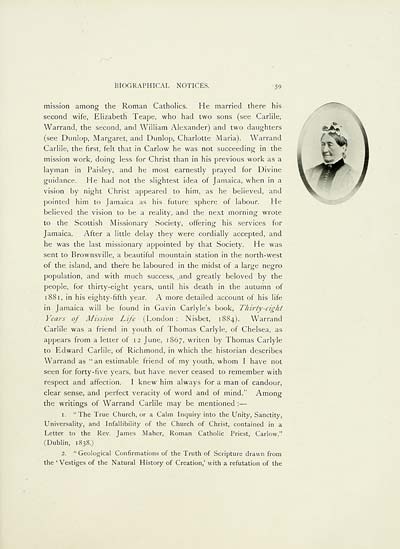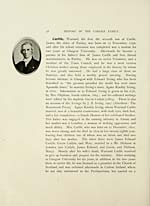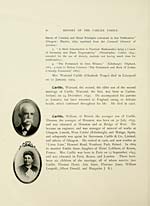History of the Carlile family
(113) Page 59
Download files
Complete book:
Individual page:
Thumbnail gallery: Grid view | List view

BIOGRAPHICAL NOTICES. 59
mission among the Roman Catholics. He married there his
second wife, Elizabeth Teape, who had two sons (see Carlile,
Warrand, the second, and William Alexander) and two daughters
(see Dunlop, Margaret, and Dunlop, Charlotte Maria). Warrand
Carlile, the first, felt that in Carlow he was not succeeding in the
mission work, doing less for Christ than in his previous work as a
layman in Paisley, and he most earnestly prayed for Divine
guidance. He had not the slightest idea of Jamaica, when in a
vision by night Christ appeared to him, as he believed, and
pointed him to Jamaica as his future sphere of labour. He
believed the vision to be a reality, and the next morning wrote
to the Scottish Missionary Society, offering his services for
Jamaica. After a little delay they were cordially accepted, and
he was the last missionary appointed by that Society. He was
sent to Brownsville, a beautiful mountain station in the north-west
of the island, and there he laboured in the midst of a large negro
population, and with much success, and greatly beloved by the.
people, for thirty-eight years, until his death in the autumn of
1 88 1, in his eighty-fifth year. A more detailed account of his life
in Jamaica will be found in Gavin Carlyle's book, Thirty-eight
Years of Mission Life (London : Nisbet, 1884). Warrand
Carlile was a friend in youth of Thomas Carlyle, of Chelsea, as
appears from a letter of 12 June, 1S67, writen by Thomas Carlyle
to Edward Carlile, of Richmond, in which the historian describes
Warrand as " an estimable friend of my youth, whom I have not
seen for forty-five years, but have never ceased to remember with
respect and affection. I knew him always for a man of candour,
clear sense, and perfect veracity of word and of mind." Among
the writings of Warrand Carlile may be mentioned : —
1. "The True Church, or a Calm Inquiry into the Unity, Sanctity,
Universality, and Infallibility of the Church of Christ, contained in a
Letter to the Rev. James Maher, Roman Catholic Priest, Carlow."
(Dublin, 1838.)
2. " Geological Confirmations of the Truth of Scripture drawn from
the ' Vestiges of the Natural History of Creation,' with a refutation of the
mission among the Roman Catholics. He married there his
second wife, Elizabeth Teape, who had two sons (see Carlile,
Warrand, the second, and William Alexander) and two daughters
(see Dunlop, Margaret, and Dunlop, Charlotte Maria). Warrand
Carlile, the first, felt that in Carlow he was not succeeding in the
mission work, doing less for Christ than in his previous work as a
layman in Paisley, and he most earnestly prayed for Divine
guidance. He had not the slightest idea of Jamaica, when in a
vision by night Christ appeared to him, as he believed, and
pointed him to Jamaica as his future sphere of labour. He
believed the vision to be a reality, and the next morning wrote
to the Scottish Missionary Society, offering his services for
Jamaica. After a little delay they were cordially accepted, and
he was the last missionary appointed by that Society. He was
sent to Brownsville, a beautiful mountain station in the north-west
of the island, and there he laboured in the midst of a large negro
population, and with much success, and greatly beloved by the.
people, for thirty-eight years, until his death in the autumn of
1 88 1, in his eighty-fifth year. A more detailed account of his life
in Jamaica will be found in Gavin Carlyle's book, Thirty-eight
Years of Mission Life (London : Nisbet, 1884). Warrand
Carlile was a friend in youth of Thomas Carlyle, of Chelsea, as
appears from a letter of 12 June, 1S67, writen by Thomas Carlyle
to Edward Carlile, of Richmond, in which the historian describes
Warrand as " an estimable friend of my youth, whom I have not
seen for forty-five years, but have never ceased to remember with
respect and affection. I knew him always for a man of candour,
clear sense, and perfect veracity of word and of mind." Among
the writings of Warrand Carlile may be mentioned : —
1. "The True Church, or a Calm Inquiry into the Unity, Sanctity,
Universality, and Infallibility of the Church of Christ, contained in a
Letter to the Rev. James Maher, Roman Catholic Priest, Carlow."
(Dublin, 1838.)
2. " Geological Confirmations of the Truth of Scripture drawn from
the ' Vestiges of the Natural History of Creation,' with a refutation of the
Set display mode to:
![]() Universal Viewer |
Universal Viewer | ![]() Mirador |
Large image | Transcription
Mirador |
Large image | Transcription
Images and transcriptions on this page, including medium image downloads, may be used under the Creative Commons Attribution 4.0 International Licence unless otherwise stated. ![]()
| Histories of Scottish families > History of the Carlile family > (113) Page 59 |
|---|
| Permanent URL | https://digital.nls.uk/95671219 |
|---|
| Description | A selection of almost 400 printed items relating to the history of Scottish families, mostly dating from the 19th and early 20th centuries. Includes memoirs, genealogies and clan histories, with a few produced by emigrant families. The earliest family history goes back to AD 916. |
|---|

